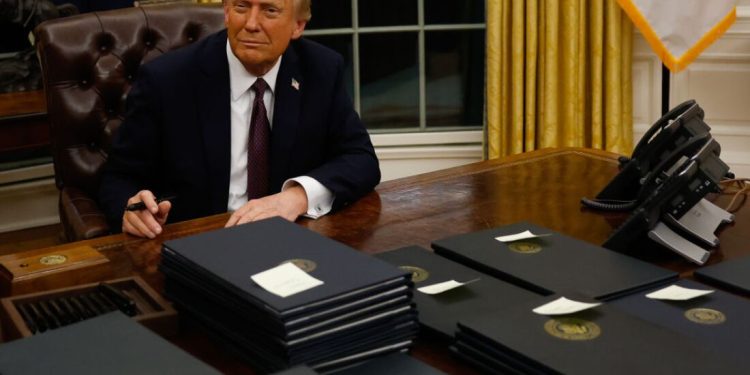
President Donald Trump signs executive orders in the Oval Office January 20, 2025 in Washington, DC.
Anna Moneymaker/Getty Images
hide caption
toggle caption
Anna Moneymaker/Getty Images
President Donald Trump’s early actions on health care signal his likely intention to erase some Biden-era programs aimed at lowering drug costs and expanding coverage in public insurance programs.
The orders he issued shortly after returning to the White House have policymakers, health care officials and patient advocates trying to read the tea leaves to determine what will happen. The guidelines, while less expansive than the orders he issued early in his first term, provide a possible road map that health researchers say could increase the number of uninsured Americans and weaken protections for safety nets for low-income people.
However, Trump’s initial directives will have little immediate impact. His administration will need to take additional regulatory steps to completely reverse Biden’s policies, and these actions do not provide a clear direction as to the direction the new president wants to take America’s healthcare system.

“Everyone is looking for signals about what Trump might do on a host of health issues. In early EOs, Trump isn’t showing his cards,” said Larry Levitt, executive vice president for health policy at KFF , the health policy research organization. polling and news organization that includes KFF Health News.
A wave of executive orders and other actions that Trump issued on his first day back in office included rolling back directives from his predecessor, former President Joe Biden, that had encouraged lower drug costs and expanding coverage under the Affordable Care Act (ACA) and Medicaid.
Executive orders “in general are nothing more than bogus internal memoranda saying, ‘Hey, agency, could you do something?'” said Nicholas Bagley, a law professor at the University of Michigan. “There may be reason to be concerned, but that’s the bottom line.”
That’s because making changes to established laws like the ACA or programs like Medicaid typically requires new rules or congressional action, which could take months. Trump has yet to win Senate confirmation for any of his picks to head federal health agencies, including Robert F. Kennedy Jr., the anti-vaccine activist and former Democratic presidential candidate whom he appointed head of the Ministry of Health and Social Services. On Monday, he named Dorothy Fink, a doctor who heads HHS’s Office of Women’s Health, as the department’s acting secretary.

“We’re getting rid of all the cancer — I call it cancer — the cancer caused by the Biden administration,” Trump told reporters while signing executive orders in the Oval Office on Jan. 20. rolling back more than 70 Biden directives, including some of the former president’s health policies, said “the previous administration embedded deeply unpopular, inflationary, illegal and sweeping practices within every office of the federal government.”
During Biden’s term, his administration implemented changes consistent with his health care orders, including extending the ACA enrollment period, increasing funding for groups that help people sign up and support for the Inflation Reduction Act, which increased subsidies to help people buy coverage. After falling under the Trump administration, enrollment in ACA plans has soared under Biden, reaching record levels each year. More than 24 million people are enrolled in ACA plans for 2025.
The drug order that Trump rescinded called on the Centers for Medicare & Medicaid Services to consider testing to reduce drug costs. The agency has proposed some ideas, such as setting a flat $2 co-pay for certain generic drugs in Medicare, the health program for people 65 and older, and asking states to try to get better prices by banding together to purchase certain expensive cell and gene therapies. .
The fact that Trump included Biden’s drug order among his revocations may indicate that he expects to do less on drug pricing this year, or even push back drug price negotiations in the Medicare framework. Or maybe it was slipped in as just another order from Biden to erase.
The White House did not respond to a request for comment.
Biden’s experiments to lower drug prices have not fully taken off, said Joseph Antos of the American Enterprise Institute, a right-wing research group. Antos said he was a little perplexed by Trump’s executive order ending the pilot programs, given that he supported the idea of tying U.S. drug costs to lower prices paid by other countries .
“As you know, Trump is a big fan of it,” Antos said. “Lower drug prices are something people can easily relate to.”
In other measures, Trump also reversed Biden’s orders on racial and gender equity and issued an order affirming that there are only two genders, male and female. HHS, under the Biden administration, has supported gender-affirming health care for transgender people and provided guidance on protecting the civil rights of transgender youth. Trump’s missive on gender intensified concerns within the LGBTQ+ community that he would seek to restrict such care.
“The administration anticipated that it would fail to protect and seek to discriminate against transgender people and anyone else it considers ‘other,’” said Omar Gonzalez-Pagan, senior attorney and care strategist at Lambda Legal, a civil rights organization. band. “We are prepared to respond to the administration’s discriminatory actions, as we have already done with great success, and to defend the ability of transgender people to access the care they need, including through Medicaid and Medicare.”
Trump also suspended new regulations being developed until they are reviewed by the new administration. He could abandon some proposals that had not yet been finalized by the Biden administration, including expanded coverage of anti-obesity drugs through Medicare and Medicaid and a rule that would limit nicotine levels in tobacco products, Katie Keith, assistant professor at Georgetown University. director of the White House Gender Policy Council under Biden, wrote in an article for Health Affairs at the forefront.
“Interestingly, he did not disrupt President Biden’s three executive orders and a presidential memorandum on reproductive health care,” she wrote.
However, Trump has asked his administration’s top brass to seek additional orders or memorandums to rescind. (He revoked the Biden order that created the Gender Policy Council.)
Democrats have criticized Trump’s actions on health care. A spokesperson for the Democratic National Committee, Alex Floyd, said in a statement that “Trump once again proves that he has lied to the American people and that he does not care about cutting costs, only what which is best for him and his ultra-rich friends.”
Trump’s decision to end a Biden-era executive order aimed at improving the ACA and Medicaid likely foreshadows coming cuts and changes to both programs, some policy experts say. His administration previously opened the door to work requirements in Medicaid — the federal-state program for low-income adults, children and people with disabilities — and previously issued guidance allowing states to cap federal Medicaid funding. Medicaid and the associated Children’s Health Insurance Program cover more than 79 million people.
“Medicaid will be a priority because it has become very broad,” said Chris Pope, a senior fellow at the Manhattan Institute, a conservative policy group. “This developed after the pandemic. The provisions expanded, such as the use of social determinants of health.”
The administration could reevaluate steps the Biden administration has taken to allow Medicaid to pay for everyday expenses some states say affect the health of its beneficiaries, including air conditioners, meals and housing.
One of Trump’s directives directs agencies to provide emergency price reductions and “eliminate unnecessary administrative expenditures and rent-seeking practices that increase health care costs.” (Rent seeking is an economic concept describing efforts to exploit the political system for financial gain without creating other benefits for society.)
“It’s unclear exactly what this refers to, and it will be interesting to see how agencies respond,” Keith wrote in his post. Health Affairs article.
Policy experts like Edwin Park of Georgetown University have also noted that, separately, Republicans are working on budget proposals that could lead to significant reductions in Medicaid funding, in part to finance tax cuts.
Sarah Lueck, vice president for health policy at the Center on Budget and Policy Priorities, a left-leaning research group, also pointed the finger at Congress: “On the one hand, what we’re seeing coming out of Trump’s executive orders is important because it shows us the direction they are taking with policy changes. But the other track is that on the Hill, there are active discussions about what’s happening in the budget legislation. They’re looking at some pretty huge cuts to Medicaid.
KFF Health News is a national newsroom that produces in-depth journalism on health issues and is one of the major operating programs of KFF .


